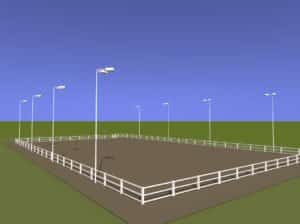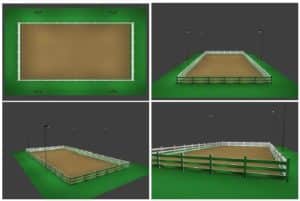Ensure Rider and Horse are Safe with LED Horse Arena Lighting

Setting up an equestrian lighting solution comes with a few added challenges. Most arena lighting is for humans only, but in this instance the horses’ visual perception must also be considered. Further, horse arenas aren’t typically built on a solid concrete foundation that allows for easy fixture installation. Lighting providers must factor this in when mounting fixtures for safety and performance reasons. And like with any arena lighting solution, efficient systems are preferred due to the sheer amount of illumination they’re expected to output.
LED lighting solutions are a good fit for equestrian arenas because they can meet these additional challenges. Horse arena lighting featuring LED technology provides excellent, even coverage that’s ideal for horse and rider alike.
What Does a Quality Horse Arena Lighting Package Include?
When setting up lighting for a large indoor or outdoor space, lighting designers rely on photometric modeling to develop the best solution. Photometric modeling allows designers to visualize the space and experiment with different types of fixtures before beginning installation.
Through photometric modeling, there are several horse arena lighting solutions available, depending on the size of the arena. High-quality equestrian lighting solutions should include the following:
- Three and four-fixture mounting arms – Every horse arena lighting package includes a collection of mounting arms, designed for three or four separate LED fixtures. Each arm is designed with brackets that mount specifically to wooden poles. Every arm is also finished with a powder coat that protects the arm from corrosion.
- LED Sportlighters (in varying wattages) – Illumination is provided by high-wattage, high-output sportlighters. The exact number depends on the arena’s size, but dozens may be required to provide even, adequate coverage.
Our LED sportlighters are capable of throwing more than 90,000 lumens in a 800 or less watt package. That’s greater than 100 lumens per watt. Every light uses glass (not plastic) optics that promote even coverage and minimal glare even after years of service. The fixture housing is IP-66 rated (the power supply is IP-67 rated) and the proprietary onboard cooling system maintains a steady 70 degrees internally, even when conditions are extreme.
Each light is rated for at least 100,000 hours of performance and can be dimmed down to a single watt when needed. If necessary, we also have high-CRI rated (>90 CRI) spotlighters that can be switched in.

How is LED Lighting Set Up at a Horse Arena?
Now that we’ve covered the components needed to provide an effective equestrian lighting solution, how they are arranged and mounted makes a big difference. That’s because equestrian lighting must account for the following challenges:
- Shadows, and how they affect a horse’s visual perception – Often times horses become frightened of shadows, which can be dangerous for both animal and rider. This may be due to slower light/dark adjusting that horse vision is known for. Providing even illumination in a horse arena can eliminate this type of issue.
Eliminating shadows on the arena floor is important, and this can be accomplished by mounting the lights high off the ground. Pole-mounted fixtures are typically mounted at a 20-foot height, but this is too low to eliminate shadows. Mounting the fixtures at 30 feet or above in height will usually do the trick. - A less stable foundation for the lighting – Horse arenas are built on sand, clay, gravel and other aggregates. This isn’t as sturdy as concrete, which is what most pole lighting is installed on. To account for less stability, wooden poles are used instead of metal to reduce weight. Our horse arena lighting is also built with a lightweight design that minimizes load bearing.
A Few Benefits of Opting for LED Technology with Horse Arena Lights
In addition to the above, LED lighting offers several advantages that legacy lighting technology can’t provide. For example, LED solutions provide:
- Superior efficiency – LED lighting is the most energy efficient on the market, especially at the system level where legacy technologies tend to lose a lot of effective lumens. That’s because LED light is directional – it can be easily aimed – so lumen losses via reflectors and omnidirectional lighting patterns aren’t as significant. You get more light for your buck, in other words.
- Extended longevity – Our sportlighters provide at least 100,000 hours of quality illumination before replacement is necessary. Compare this to metal halides, which are well into their decline phase by 10,000 hours. A long lifespan is extremely valuable for equestrian lighting because the poles are higher, and it takes more effort to switch out a dead bulb.
That means more money spent per replacement, so reducing replacement frequency is a sure way to keep maintenance costs under control. - Easier cooling – LED lighting emits far less heat than older lighting options, including metal halides. In the sweltering south and southwest, heat is a real threat to lighting and can cause early failure if not addressed. With LED lighting, it’s easier to control thermal levels due to LED’s reduced heat output, and the active cooling built into our sportlighters mitigates heat-related concerns further.
- Excellent controllability – LED lighting is also the most controllable type of fixture on the market, so it can be attached to a variety of cost-saving technologies. Dimmers are one option, but so are timers, photocells, and occupancy controls. With the use of smart controls, LED lighting solutions can achieve even greater levels of efficiency.
Special considerations must be made when designing and installing horse arena lighting. Considerations that LED lighting solutions are best equipped to handle. LED lighting has already become a frontline option for many types of sports arenas – and now it’s the first choice among horse arena lighting as well.







